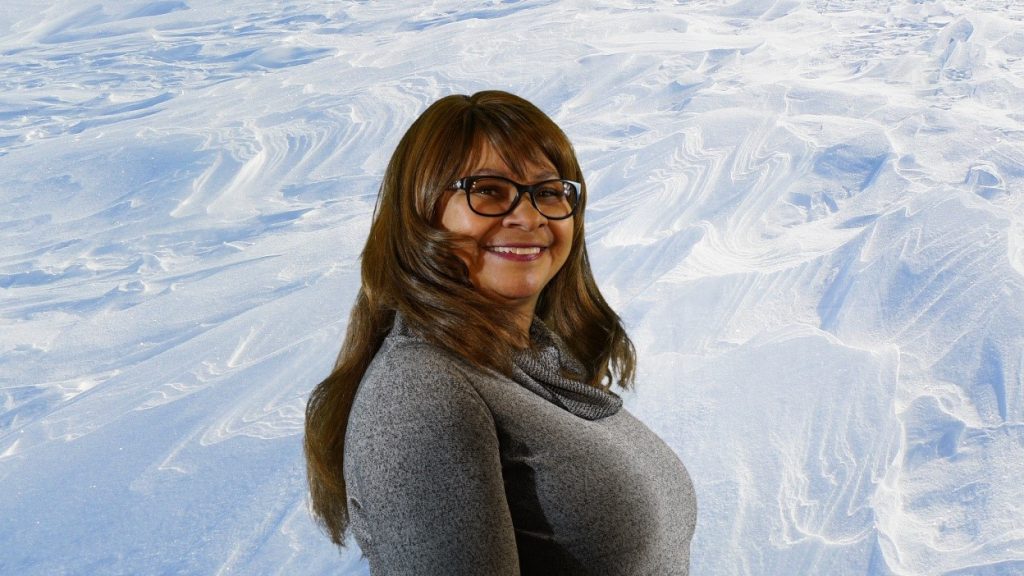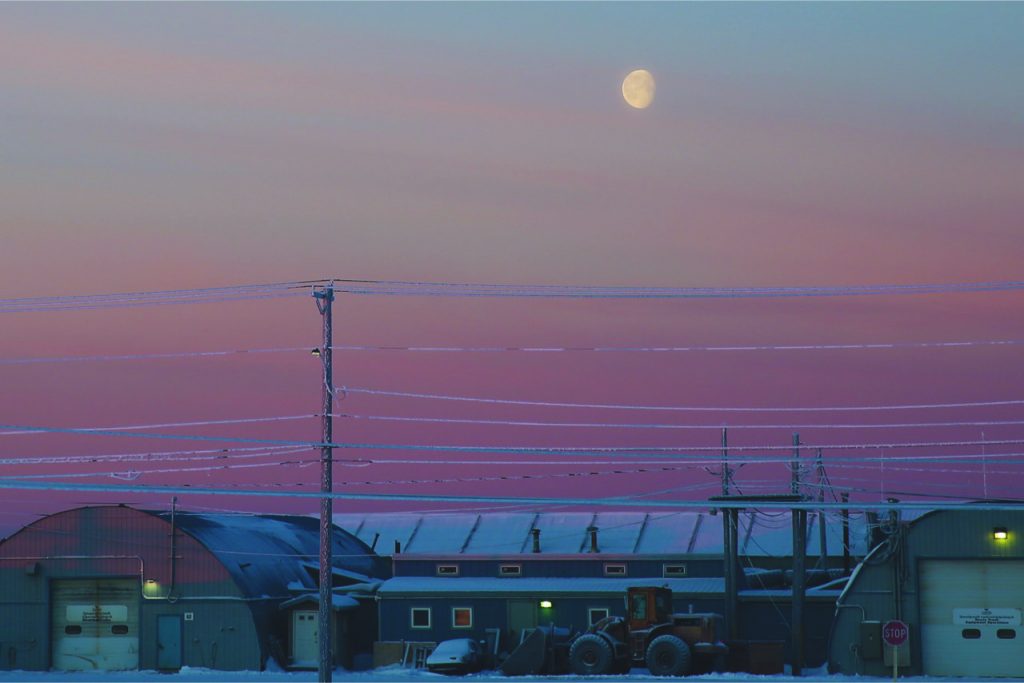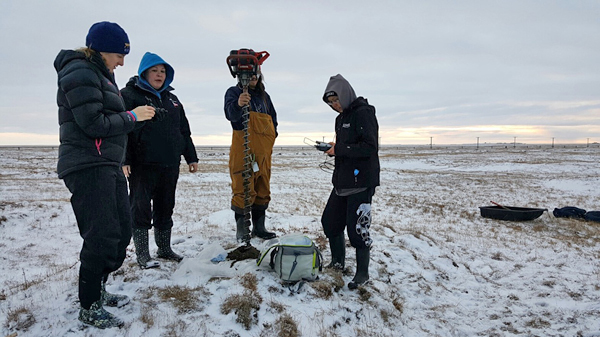In a climate many outsiders find inhospitable, Iḷisaġvik College science instructor Linda Nicholas-Figueroa, a transplant from the American South, has made the Arctic Circle her home. She was recently named an AAAS Fellow for her innovative approaches to teaching and place-based research.
By Melanie Lenart

Living in the Arctic Circle can sound romantic, but few outsiders try it, and fewer have the stamina to stay. For Dr. Linda Nicholas-Figueroa, a transplant from the lower 48, the North Slope of Alaska is home. For the past 11 years, Nicholas-Figueroa has served as the only science faculty member at Iḷisaġvik College, a tribally controlled college located 300 miles above the Arctic Circle.
“From my lab, I can see the Arctic Ocean,” she said during a Zoom conversation in mid-November from her office in Utqiagvik (formerly known as Barrow).
It’s a view now obscured by the continuous darkness that comes with living near the North Pole in winter. “Our sun sets actually this Friday for the last time for approximately two months,” she said. “So even though there might be a little bit of twilight, it’s not light enough to actually be out in the field.”
Nonetheless, she was busy preparing for a student-focused field trip to use a NASA-donated telescope to view the full solar eclipse on November 18. Like much of daily life in the coldest state, the outing all depended on the weather. Even with a warming climate, blizzards remain a common feature during Arctic winters, while thinning ice in many areas makes it more challenging to travel safely.
It’s not for the faint of heart, but Nicholas-Figueroa has thrived, helping to build the college’s growing STEM program while also maintaining an active research program monitoring the region’s changing climate. Before becoming an associate professor at Iḷisaġvik College, she worked as a chemistry instructor for the Rural Alaska Honors Institute with the University of Alaska Fairbanks.
Her efforts to make the tribal college’s curriculum accessible and reflective of the region’s indigenous cultures has garnered both grants and accolades. Earlier this year, the American Association of the Advancement of Science inducted her as an AAAS fellow for “20 years of excellence in teaching and mentoring Native Alaskan students and for her scholarship on culturally sensitive and place-based approaches to learning science.”

Integrating western and indigenous approaches
Nicholas-Figueroa worked at Iḷisaġvik College full-time for many years before receiving her doctorate degree in Science Education from the University of Alaska-Fairbanks in 2017, focusing her research on the integration of western science and indigenous knowledge.
A Black woman with no tribal affiliation, she nonetheless experienced many of the same issues facing many people of color, growing up in primarily white communities in Texas, Mississippi and Idaho. During a decade-long stint as a surgical technologist in the Army, Nicholas-Figueroa moved even further outside of her cultural comfort zone while working in Germany. At some point, she realized she would prefer a career in the natural sciences rather than the medical field.
Her father had been a paramedic in the military, but she was the first one in her family to pursue higher education, earning a bachelor’s degree in biochemistry and a master’s degree in chemistry before receiving her doctorate. Along with her years working at Iḷisaġvik College, whose diverse student body averages about 60 percent Native Alaskan, her academic background gives her a strong background for integrating indigenous knowledge with western science.
In a research paper she coauthored in 2017, Nicholas-Figueroa quotes Albert Marshall, an aboriginal Elder of the Mi’kmaw Nation in Canada, describing the integration of the two approaches “Two-Eyed Seeing.”
She focuses on place-based research on topics and questions deemed important by local community members by encouraging the students to pursue topics reflecting their own interests. She incorporates elders and other community members with specific skills into courses either through co-instruction, guest lecturing, or via interviews conducted by students.
Nicholas-Figueroa also takes the students on field trips to locations that will help put abstract knowledge into a practical, useful framework. For instance, she has used field trips to the Aerosol Time-Flight Mass Spectrometer to bring home how black carbon makes its way from industrialized countries to the Arctic. In general, she favors hands-on work whenever possible.
Hands-on research as a way to learn STEM
Nicholas-Figueroa has had to be innovative to instruct the Iñupiaq citizens spread across the North Slope—about 89,000 square miles of the northernmost portion of the state—and other students from abroad, such as in the Philippines and Thailand. About three years before the pandemic struck, she began teaching all her courses remotely.
“I’m a big fan of it,” she said of using Zoom for distance learning. “It benefits a lot of people. Daycare is really hard to find up here.”
Students also participate in classroom discussions or personal interviews with local elders during the semester as they work on individualized place-based projects. They use these interactions to help them integrate indigenous science—sometimes called Traditional Ecological Knowledge, with the caveat that it’s always evolving—into the papers they write about their STEM-related research.
To support students studying remotely, Nicholas-Figueroa will even mail equipment needed to conduct research. For instance, she’s mailed chloride ion probes to students interested in considering effects of the additional salt—sodium chloride—from the sea as near-shore ice melts. Another student measured sulfate ions, known to accelerate snowmelt, on snow in Fairbanks. Other students consider climate-change-related effects on hunting caribou, or on specific species, such as tomcod fish or salmon.
In determining the chloride ion levels of snow samples, she and her students incorporated traditional knowledge about snow, including the many descriptions for it in the Inuit language, through interviews with community members and elders. Students also presented their findings to the community, documenting feedback to help direct future research efforts.
Over the years, Nicholas-Figueroa has secured funding from the National Science Foundation and other organizations to help her bring research into the classroom or conduct projects, workshops and summer camps with a variety of students.
Two NSF grants running from 2016 to 2019 allowed her to engage dozens of students, including three whose work as interns also provided them with scholarships for bachelor’s degree work at the University of Alaska in Fairbanks, in a research project to test for microbes that might be freed from melting permafrost. She engaged students by incorporating her Arctic Microbe research into her microbiology class.
During the Zoom conversation with Native Science Report, she held up a small box the size of a harmonica called a Nanopore MinIonsequencer used for DNA analysis. This small instrument allows her students to inject a syringe of DNA extractions and attach it to their laptop computers for quick sequencing. Using that technique on samples from the soil that is typically frozen year-round, known as permafrost, she and the students found DNA from a variety of gram-negative bacteria. One of these was Pseudomonas brassicacearum, which can help suppress soil-borne pathogens.
Using Illumina Base-Space sequencing, students found DNA matching the bacteria Mycobacterium simulans, which can cause lung problems similar to tuberculosis.
“In Alaska, we have the highest TB rate in the U.S.,” she said, using the abbreviation for tuberculosis. “That was another reason this was of interest to us.”
Summer camps are another way Nicholas-Figueroa lures students into science. She offers a STEM camp for middle school students to pique their interest in science early on. High school and college students can receive college credit for participating in her summer camps, a one-week Methods in Molecular Biology STEM camp and a two-week camp with a focus on climate change called Environmental Health in a Changing Arctic.

An ideal location for climate change research
Alaskan residents in all walks of life are on the front lines of the ongoing climate change, so most students have some sense of the problem.
“Up here where we are, it’s changing drastically compared to the rest of the world,” Nicholas-Figueroa said.
The Arctic has seen a temperature rise about three times higher than the globe as a whole, with an increase surpassing 5 degrees Fahrenheit since 1971, according to a report released in May by the Arctic Monitoring and Assessment Programme.
To help illustrate the abstract science, the Iḷisaġvik associate professor takes students on field trips to a National Ocean and Atmospheric Administration laboratory in Utqiaġvik that measures carbon dioxide and other greenhouse gases. Seeing the equipment and the measurements helps students understand how the warming blanket of atmospheric gases—released by the use of coal, oil and gas to fuel cars, heat homes and produce electricity—drives the ongoing temperature rise.
Summer temperatures haven’t changed much during her time in Alaska, Nicholas-Figueroa said, but the summers have gotten longer. Meanwhile, winter temperatures have warmed drastically. As a result, she said, Arctic ice that used to form along the shoreline in November now often doesn’t arrive until January.
The declining ice cover has freed the sea to cause more damage on Alaska’s North Shore.
“The road I use to take the kids to college floods a lot,” Nicholas-Figueroa said. “We do have significant erosion. That is something I noticed since I’ve been here. The beaches are getting shorter. There are places where houses are right on the bluff now.”
The Iñupiaq have some 28 words to describe ice in its various forms, with a vocabulary that encompasses the concept of whether that ice is safe for traveling on. Unfortunately, the instability of the ice hampered her research efforts this October.
“I was going to take my students out collecting snow samples for a project that we’re doing. We have a thousand lakes in this region and I didn’t want to take any chances that they weren’t frozen.”
The drastic changes occurring in the Arctic have brought a slew of climate researchers to the area. In a 2015 journal article Nicholas-Figueroa wrote with others, the authors noted that Iḷisaġvik College was seeking “to broaden STEM education on the North Slope to meet the needs of employers and research in fields such as climate science.”
Concerns about climate change, along with her decades of teaching science in Alaska, have no doubt contributed to a growing interest in STEM programs. The number Native Alaskan students attending the University of Alaska at Anchorage and Fairbanks roughly quintupled between 1997 and 2012, according to a chart published in her journal article.
In such a drastically changing environment, even the students who don’t become scientists stand to benefit from the science courses required for Iḷisaġvik College’s two-year associate’s degrees.
“You need to know science. Everybody needs to know science. Not in detail—there are so many different subjects and everything,” Nicholas-Figueroa said. “But like with climate change, or global warming, you need to be able to pick up an article. You need to be able to read it, you need to be able to read a graph, so you can make your own decisions.”
Melanie Lenart is a regular contributor to Native Science Report. Published December 7, 2021
• • •
Enjoyed this story? Enter your email to receive notifications.
